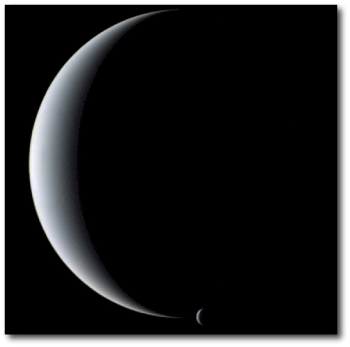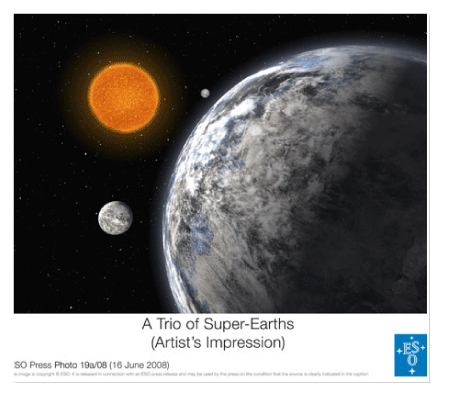
This morning, I awoke to an inbox full of indications that there was indeed plenty of drama in the club.
From one of our correspondents:
He threw out dozens of new systems, very graphically, on slips of paper, like playing cards, floating down on a pile on the screen. Very dramatic. But no HD numbers on those slips!
He predicts 1 to 1.5 Earth sensitivity by around 2010 (extrapolating a trend).
He has been monitoring about 400 FGK slow rotators since 2004, with HARPS.
Can do 0.5 m/s today, 0.1 m/s in near future.
Noise sources are astroseismology, which settles to about 0.1 m/s after 15 minutes of integration, and a worse one, star spots, which settle to about 0.5 m/s after 15 minutes but do not drop lower, even though theory says level should drop to about 0.1 m/s.
He says he has 40 new candidates in the 30-50 day period range, and mass less than 30 Earths.
Nevertheless, after the drama, he did report 3 Neptune-type systems, all focused on the Super Earth theme of the meeting.
The centerpiece was definitely HD 40307, a deep southern K2.5 V star only 40 light years distant, with a metallicity roughly half that of the Sun. It has three detected planets, with Msin(i)’s of 4.2, 6.9, and 9.2 Earth masses, and corresponding periods of 4.31, 9.62, and 20.45 days. It’s fascinating that these planets are close to, but aren’t actually in a 4:2:1 resonance. This is really a remarkable detection.
With 40 candidates in the pocket, the Geneva team does, however, seem to be keeping some of their powder dry, perhaps in anticipation of a low-mass transit. Here’s a link to the ESO press release, which has triggered 93 news articles and counting.
In the press release image, HD 40307d is definitely all that and a bag of chips. Puffy white clouds, azure seas, continents, soft off-stage lighting…


Pingback: Interesting extrasolar planet discoveries - Page 9 - Bad Astronomy and Universe Today Forum
These are all bright (some among the brightest!) stars with short-period planets. I assume the discovery team has looked for transits, but can anyone confirm this?
Also, it is just me, or do hot Jupiter systems seem to be single (HD209458, 51 Peg, etc.), while hot Neptune systems seem to be in multiples (these systems, GJ 876, GJ 581, etc.). There is an observational bias here (transiting systems – the source of hot Jupiters these days – don’t have enough observations to detect more distant planets), but I’m starting to wonder if this ties in to the core accretion / migration process, perhaps related to Greg’s conjection about a mass valley. On the super-massive (> 2 M_J) end, heavy planets are the only close-in planets with detectable eccentricities (WASP-10, WASP-14 being recent examples) which might be telling us about eccentricity evolution due to tides or other interesting physics.
Just goes to show you that detecting ~300 planets doesn’t mean we’ve found all the interesting trends yet.
No confirmation, just speculation: My guess is that they are pretty confident in transit non-detections for the planets that they are releasing with periods less than 10-20 days. I would bet that a prime reason for withholding the HD numbers for many of their other systems is that their photometric follow-up is still incomplete. It’s got to take quite a while, even with several sites, to get all these planets vetted.
Just as Greg promised in the “Worlds” posting — here come the Super Earths raining down on us from the Andes! It’s a beautiful storm! Meanwhile I have to wonder — how do the Europeans keep pulling these rabbits out of their hats? Is it better instrumentation (HARPS) or a better observing strategy, or both?
In The New York Times article on this big announcement, Dennis Overbye makes it sound kind of like an event in the Exoplanet Olympics:
——————————–
In a terse statement, Dr. Mayor’s main rivals, a group of planet hunters led by Geoff Marcy of the University of California, Berkeley, and Paul Butler of the Carnegie Institution of Washington, said they were doing their own survey, to be completed within a year.
“Our survey will check the Swiss report that 30 percent of stars have super-Earths or Neptunes orbiting closer than Mercury does the Sun,” the group said in an e-mail message.
—————————–
I’m really curious about HD 181433, which is apparently a K giant. Its inner planet is on a much tighter orbit than the planets of the “retired A stars” that John Johnson and others have been finding. But I don’t find any data on its mass, which would indicate what its main sequence spectral type might have been. I guess we’ll find out whenever the discovery papers appear.
Bucky: regarding HD 181433, the luminosity implied from its magnitude and Hipparcos parallax fits in with it being a K dwarf, as opposed to the K3III-IV listed on SIMBAD. In fact, its entry in the Hipparcos catalogue lists it as K5V.